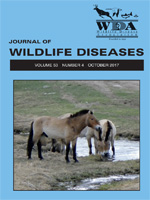Free-ranging yellow armadillos (Euphractus sexcinctus) from the Brazilian Pantanal were captured for surgical implantation of intra-abdominal radio transmitters. During March 2014, 11 animals were chemically immobilized with a combination of intramuscular ketamine hydrochloride, xylazine hydrochloride, midazolam maleate, and atropine sulfate. The mean induction time and initial heart rate in males was higher than in females. The sex of armadillos did not affect the respiratory rate, which increased from the beginning to end of the monitoring time. The rectal temperatures of females remained almost unchanged, whereas the rectal temperatures of males suffered a slight drop through the procedure. The mean (±SD) total surgical time was 50±6.5 min, and the total anesthetic recovery time was 2.5±0.5 h. The armadillos were monitored for 24 h after surgery and released at their capture site. The anesthetic association was effective, promoting muscle relaxation and analgesia that allowed the performance of surgical procedures.
How to translate text using browser tools
1 October 2017
Chemical Immobilization of Free-ranging Yellow Armadillos (Euphractus sexcinctus) for Implantation of Intra-abdominal Transmitters
Vinicius Peron de Oliveira Gasparotto,
Nina Attias,
Flávia Regina Miranda,
Grazielle Cristina Garcia Soresini,
Ariel da Costa Canena,,
Guilherme Mourão
ACCESS THE FULL ARTICLE

Journal of Wildlife Diseases
Vol. 53 • No. 4
October 2017
Vol. 53 • No. 4
October 2017
Anesthesia
armadillo
Brazilian Pantanal
intra-abdominal radio transmitter
telemetry
Xenarthra




